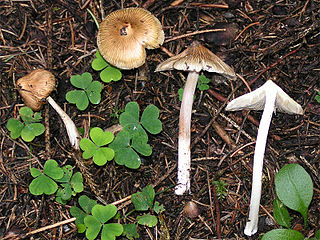
Inocybe is a large genus of mushroom-forming fungi with over 1400 species, including all forms and variations. Members of Inocybe are mycorrhizal, and some evidence shows that the high degree of speciation in the genus is due to adaptation to different trees and perhaps even local environments.

Amanita arocheae, also known as the Latin American death cap, is a mushroom of the large genus Amanita, which occurs in Colombia, Central America and South America. Deadly poisonous, it is a member of section Phalloideae and related to the death cap, A. phalloides.
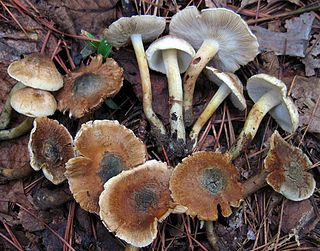
Inocybe corydalina var. corydalina, commonly known as the greenflush fibrecap, is a member of the genus Inocybe which is widely distributed in temperate forests. It is a small mycorrhizal mushroom which contains a small amount of the hallucinogen psilocybin.

Inocybe geophylla, commonly known as the earthy inocybe, common white inocybe or white fibercap, is a poisonous mushroom of the genus Inocybe. It is widespread and common in Europe and North America, appearing under both conifer and deciduous trees in summer and autumn. The fruiting body is a small all-white or cream mushroom with a fibrous silky umbonate cap and adnexed gills. An all-lilac variety lilacina is also common.

Mythicomyces is a fungal genus in the family Mythicomycetaceae. A monotypic genus, it contains the single species Mythicomyces corneipes, first described by Elias Fries in 1861. The fungus produces fruit bodies with shiny yellowish-orange to tawny caps that are 1–3 cm (0.4–1.2 in) in diameter. These are supported by stems measuring 2–5.7 cm (0.8–2.2 in) long and 1–2 mm thick. A rare to uncommon species, it is found in northern temperate regions of North America and Europe, where it typically fruits in groups, in wet areas of coniferous forests. There are several species with which M. corneipes might be confused due to a comparable appearance or similar range and habitat, but microscopic characteristics can be used to reliably distinguish between them.

Inocybe lacera, commonly known as the torn fibrecap, is a poisonous species of mushroom in the genus Inocybe. Its appearance is that of a typical "little brown mushroom": small, brown and indistinct. However, it is distinguishable by its microscopic features, particularly its long, smooth spores. As with many other species of Inocybe, I. lacera contains the poisonous chemical muscarine which, if consumed, can lead to salivation, lacrimation, urination, defecation, gastrointestinal problems and vomiting. Found in Europe and North America, it typically grows in autumn in mixed woods, favouring sandy soil. There are several documented subspecies in addition to the main I. lacera var lacera, including the dwarf form I. lacera var. subsquarrosa and I. lacera var. heterosperma, found in North America.
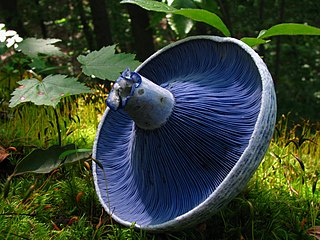
Lactarius indigo, commonly known as the indigo milk cap, indigo milky, the indigo lactarius, or the blue milk mushroom, is a species of agaric fungus in the family Russulaceae. It is a widely distributed species, growing naturally in eastern North America, East Asia, and Central America; it has also been reported in southern France. L. indigo grows on the ground in both deciduous and coniferous forests, where it forms mycorrhizal associations with a broad range of trees. The fruit body color ranges from dark blue in fresh specimens to pale blue-gray in older ones. The milk, or latex, that oozes when the mushroom tissue is cut or broken — a feature common to all members of the genus Lactarius — is also indigo blue, but slowly turns green upon exposure to air. The cap has a diameter of 5–15 cm (2–6 in), and the stem is 2–8 cm (0.8–3 in) tall and 1–2.5 cm (0.4–1.0 in) thick. It is an edible mushroom, and is sold in rural markets in China, Guatemala, and Mexico. In Honduras, the mushroom is called a chora, and is generally eaten with egg; generally as a side dish for a bigger meal.
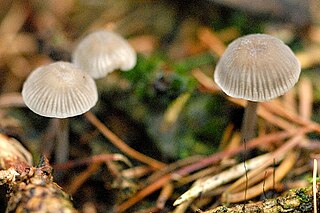
Mycena cinerella, commonly known as the mealy bonnet, is an inedible species of mushroom in the family Mycenaceae. It is found in Europe and the United States, where it grows in groups on fallen leaves and needles under pine and Douglas fir. The small grayish mushrooms have caps that are up to 1.5 cm (0.6 in) wide atop stipes that are 5 cm (2.0 in) long and 2.5 mm (0.10 in) thick. Its gills are grayish-white and adnate, with a "tooth" that runs slightly down the stipe. The fungus has both two- and four-spored basidia. As its common name suggests, it smells mealy.

Cortinarius anomalus, also known as the variable webcap, is a basidiomycete fungus of the genus Cortinarius. It produces a medium-sized mushroom with a grayish-brown cap up to 5 cm (2 in) wide, gray-violet gills and a whitish stem with pale yellow belts below. The mushroom grows solitarily or in scattered groups on the ground in deciduous and coniferous forests. It is found throughout the temperate zone of the northern hemisphere.

Ripartites tricholoma, commonly known as the bearded seamine, is a species of fungus in the family Tricholomataceae. It was first described scientifically as Agaricus tricholoma by Albertini and Lewis David von Schweinitz in 1805, and later transferred into the genus Ripartites by Petter Karsten in 1879. It is found in North America and Europe, and has also been collected in Costa Rica.
Tricholosporum violaceum is a species of fungus in the family Tricholomataceae. Found in Costa Rica, the species was described as new to science in 1996.

Phaeocollybia christinae, commonly known as Christina's rootshank, is a species of fungus in the family Cortinariaceae. Found in the woodlands of Europe and eastern North America, it typically grows in sandy soil near conifer trees, especially spruce. The fruit bodies are characterized by a brownish cap with a pointed umbo, and a long stem that extends deeply into the soil.

Cortinarius camphoratus, commonly known as the goatcheese webcap, is an agaric fungus in the family Cortinariaceae. The fungus is found in Europe and North America, where its fruit bodies (mushrooms) grow on the ground in a mycorrhizal association with spruce and firs in coniferous forests. Mushrooms are characterized by pale blue lilac colors when young, and a strong distinctive odor. Sources disagree as to the edibility of the mushroom, but they are generally not recommended for eating.

Pulveroboletus ravenelii, commonly known as Ravenel's bolete or the powdery sulfur bolete, is a species of bolete fungus in the family Boletaceae. Described as new to science in 1853, the widely distributed species is known from Asia, Australia, North America, Central America, and South America. Mycorrhizal with oak, the fungus fruits on the ground singly, scattered, or in groups in woods. Fruit bodies (mushrooms) have convex to flat, yellowish to brownish-red caps up to 10 cm (4 in) in diameter. On the cap underside, the pore surface is bright yellow before turning dingy yellow to grayish brown with age; it stains greenish blue then grayish brown after injury. A cottony and powdery partial veil remains as a ring on the stipe. The mushrooms are edible, and have been used in traditional Chinese medicine and for mushroom dyeing.

Boletus vermiculosus is a species of bolete fungus in the family Boletaceae. Found in North America, it was described as new to science in 1872 by mycologist Charles Horton Peck.
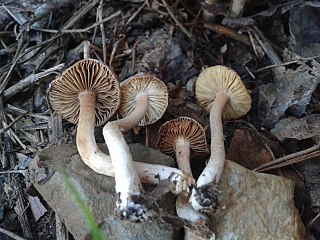
Inocybe griseolilacina, commonly known as the lilac leg fibrecap, is a mushroom in the family Inocybaceae. It was described scientifically by Danish mycologist Jakob Emanuel Lange in 1917. It is inedible. Its distinguishing characteristic is its pale yellow-gray and scaly cap and its fibrillose lilac stipe.

Harrya chromapes, commonly known as the yellowfoot bolete or the chrome-footed bolete, is a species of bolete fungus in the family Boletaceae. The bolete is found in eastern North America, Costa Rica, and eastern Asia, where it grows on the ground, in a mycorrhizal association with deciduous and coniferous trees. Fruit bodies have smooth, rose-pink caps that are initially convex before flattening out. The pores on the cap undersurface are white, aging to a pale pink as the spores mature. The thick stipe has fine pink or reddish dots (scabers), and is white to pinkish but with a bright yellow base. The mushrooms are edible but are popular with insects, and so they are often infested with maggots.
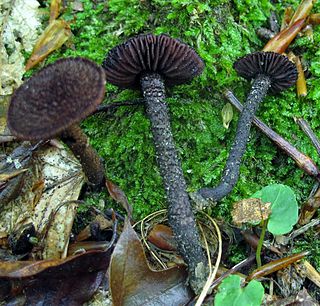
Inocybe tahquamenonensis is an inedible species of agaric fungus in the family Inocybaceae. Found in the United States, it was formally described in 1954 by mycologist Daniel E. Stuntz. The fruit bodies have bell-shaped to convex to flattened caps measuring 1.2–3 cm (0.5–1.2 in) in diameter. Its color is dark purplish brown to reddish- or blackish-brown, with reddish-purple flesh. The gills are attached to the stipe and are somewhat distantly spaced. They are initially reddish brown before turning to chocolate brown, sometimes developing whitish edges. The spore print is brown; spores measure 6–8.5 by 5–6 μm. Fruit bodies grow singly, scattered, or in group under deciduous trees.

Sutorius eximius, commonly known as the lilac-brown bolete, is a species of fungus in the family Boletaceae. This bolete produces fruit bodies that are dark purple to chocolate brown in color with a smooth cap, a finely scaly stipe, and a reddish-brown spore print. The tiny pores on the cap underside are chocolate to violet brown. It is widely distributed, having been recorded on North America, South America, and Asia, where it grows in a mycorrhizal relationship with both coniferous and deciduous trees.
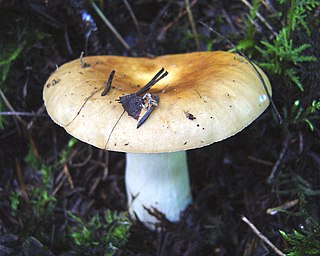
Russula mustelina, commonly known as the russet brittlegill, is a basidiomycete mushroom of the genus Russula native to Europe and North America. Swedish mycologist Elias Magnus Fries described the species in his 1838 book Epicrisis Systematis Mycologici seu Synopsis Hymenomycetum.



















